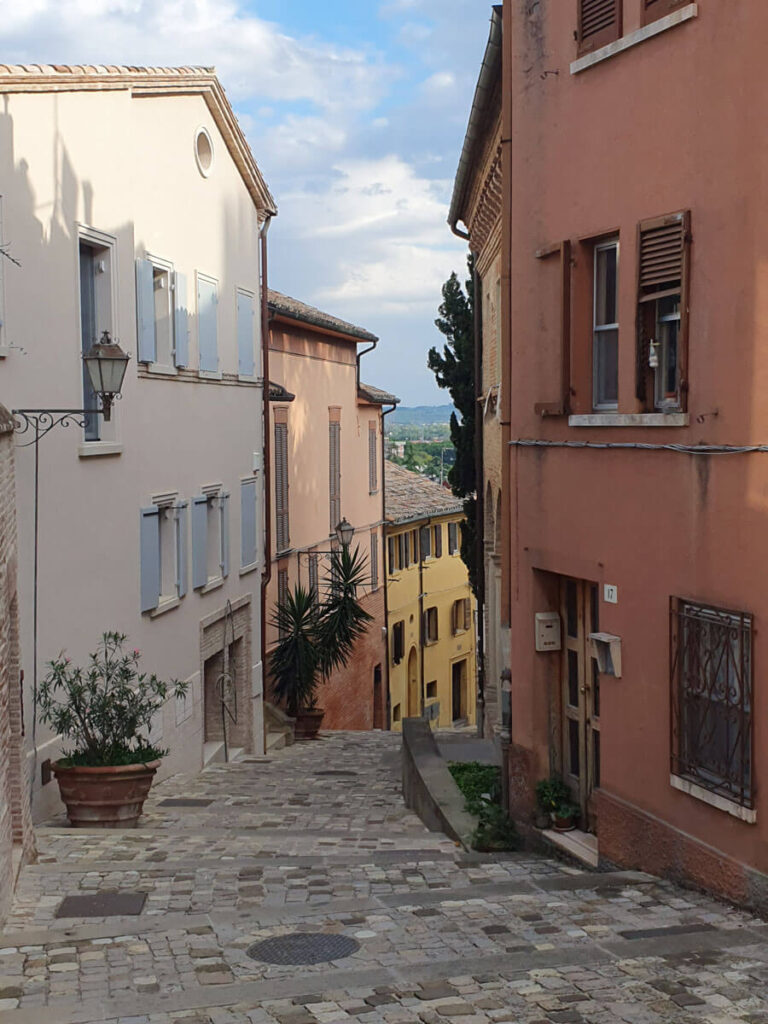Santarcangelo di Romagna is a small and picturesque historic town close to Rimini and the Adriatic sea. It makes a great excursion from Rimini and other local beach resorts, especially when one of the town’s lively historic fairs is taking place. Santarcangelo is named for its patron saint, St Michael Archangel. The ‘di Romagna’ part of its name describes its location in this part of the Emilia-Romagna region to distinguish it from other similarly-named villages in Italy.
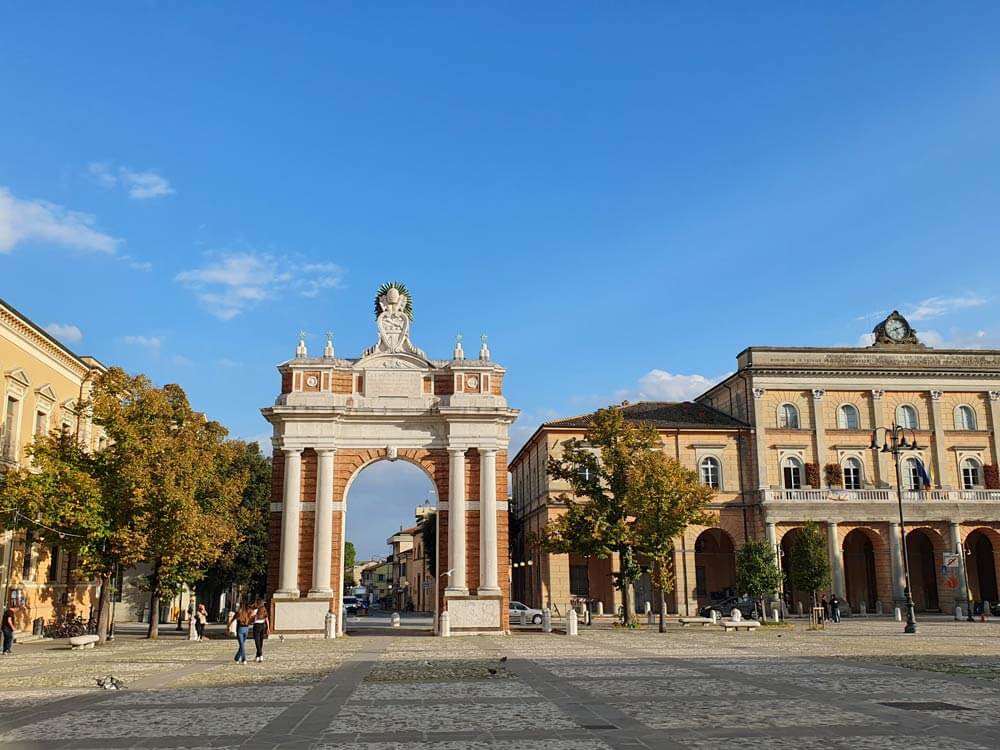
While Santarcangelo di Romagna has the typical appealing attributes you’d expect of a historic hill town in Italy – churches, views, restaurants, museums – it also has a few surprises which make it special. The greatest of these is an underground world to discover. The hill beneath the town is riddled with man-made caves and tunnels forming an intriguing and extensive labyrinth. Although visitors can’t explore the whole network, you can visit a cave complex on regular guided tours. And on special occasions, longer tours are also available – I was lucky and managed to visit several mysterious grottoes during a town festival.
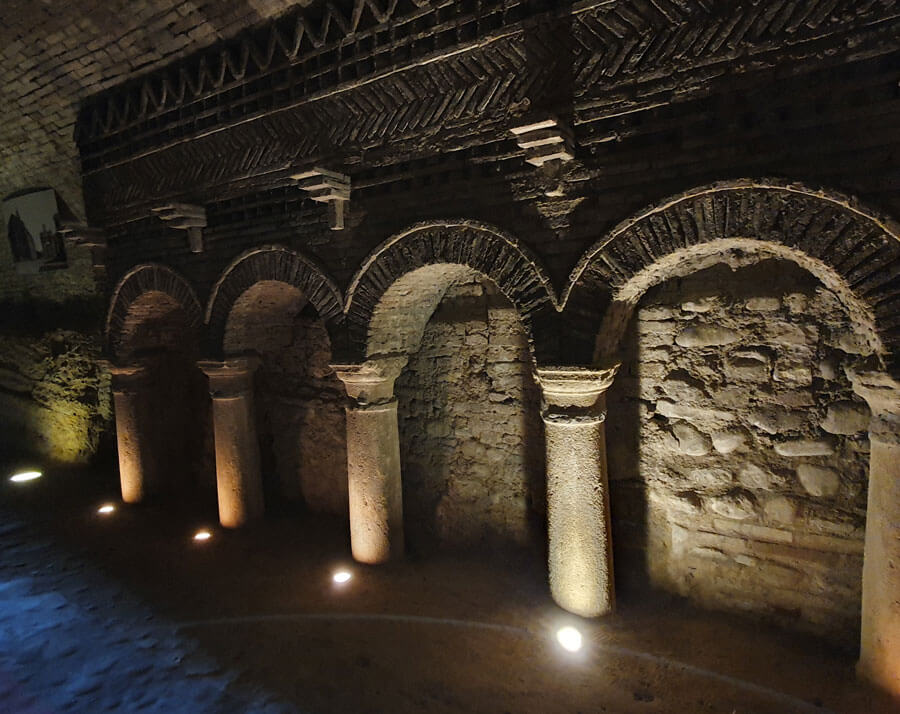
Stay in Santarcangelo di Romagna
As Santarcangelo di Romagna is an attractive little town with a welcoming atmosphere, it would make a good place to stay and soak up the atmosphere, slow travel-style. Transport connections are decent, with a bus to Rimini and to Rimini airport, so it may appeal as a base for a few nights when exploring the area – away from the hustle of the region’s seaside resorts, while still within easy reach of the sea. Even if you’re just passing through, Santarcangelo is a good choice for an overnight stop, offering excellent food, sightseeing and strolling. There are some tempting accommodation options in and around Santarcangelo, from B&Bs in the historic centre to countryside stays among vineyards.
- Find accommodation in Santarcangelo di Romagna
- or consider:
- Hotel della Porta – convenient 4-star town hotel with character, a short walk from the historic centre
- B&B Maison Biagetti – comfortable B&B a few yards from Piazza Ganganelli, handy for buses and restaurants
- B&B Villa Ebe – popular B&B in a stylish villa a short walk from the centre, highly-rated by guests. Has car parking
- La Foresteria del Convento – stay in a historic working convent with the nuns: guestrooms & a hidden garden in the centro storico
- Residenza e Campanoun – 2-bed holiday let in a little house in the heart of the hilltop centre (note it’s close to the belltower!)
- Collina dei Poeti – not far from Santarcangelo, the ‘Hill of the Poets’ is a wine estate offering peaceful rural stays
Accommodation links on this website are affiliate links: if you make bookings through these you will be supporting this website without paying any extra. If you’ve found my destination guides helpful, please consider using or bookmarking my affiliate links, or buying me a coffee to help keep this website online. Thank you!
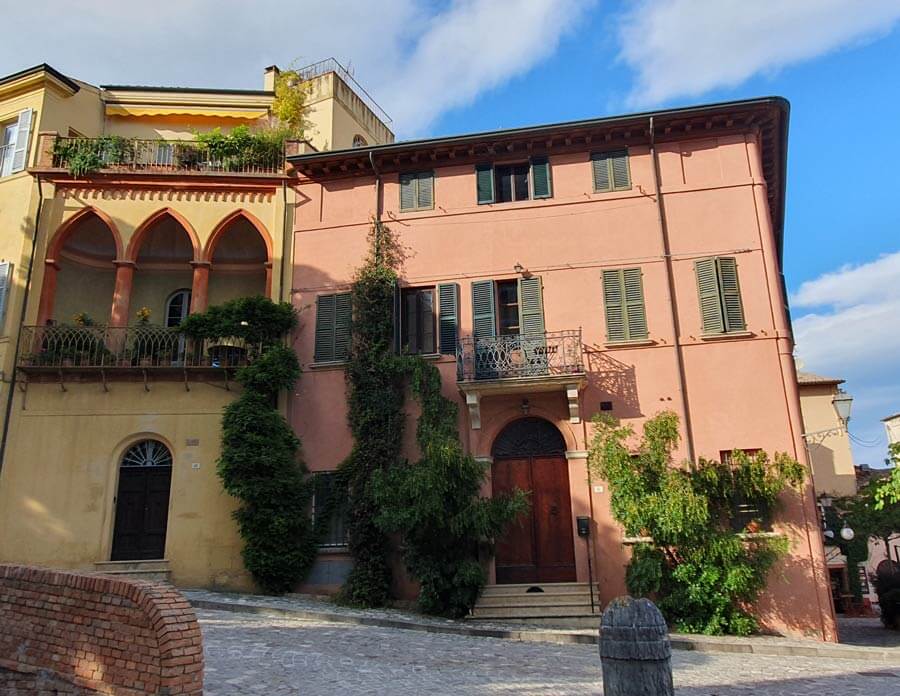
What to see and do in Santarcangelo di Romagna
The first and best way to enjoy Santarcangelo di Romagna is to explore its picturesque streets, discover panoramic viewpoints and soak up the welcoming small-town atmosphere. The historic old town on the hill has a quaint and village-y feel, while the lower part of town has a choice of appealing restaurants, cafés and bars. It’s not a large town and in the historic centre there are only a few streets to explore, so it’s easily manageable on foot and in not much time.
The local tourist information office (IAT), housed in a little temple to tourism on the central Via Battisti, is active at welcoming visitors and sharing Santarcangelo’s history and attractions. They organise guided tours of the caves under the hill, and I’d recommend booking one of these if you can; I’ve written more about the caves and their mysteries below.
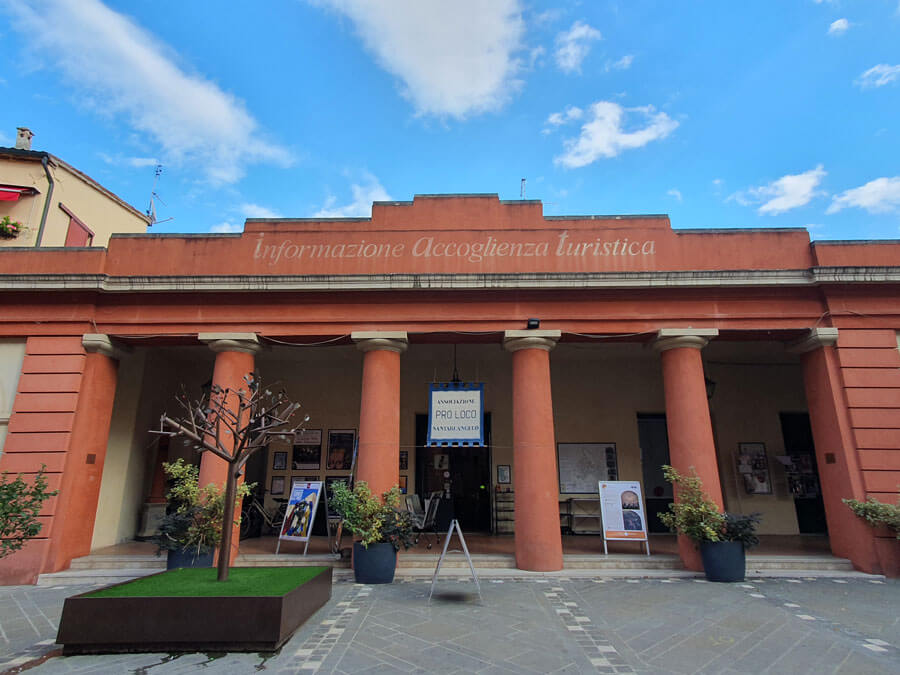
As well as the sights and views you’ll discover strolling around Santarcangelo and the interest of a cave tour, the town has several other attractions. There’s a good museum, a tribute to a pope, food and drink to enjoy and a fascinating, unique piece of history inside a shop. Read on for more detail.
Cave tours
The hill on which Santarcangelo sits is honeycombed with man-made caves and tunnels. There’s a lot of mystery around how old these are and what their various functions might have been over the centuries. One purpose is obvious: storage. Some of the caves are still used as cellars for food, wine and other goods. Another practical function is refuge and escape. During the Second World War the network of tunnels was used by terrified residents to shelter as bombing shook the region’s towns. Further back in time, it may be that some of the underground chambers were created as places of worship; there are some suggestive circular domed chambers reminiscent of churches. And in the intervening centuries the tunnels would have offered both useful hiding-places and escape routes as well as food storage in times of uncertainty and conflict.
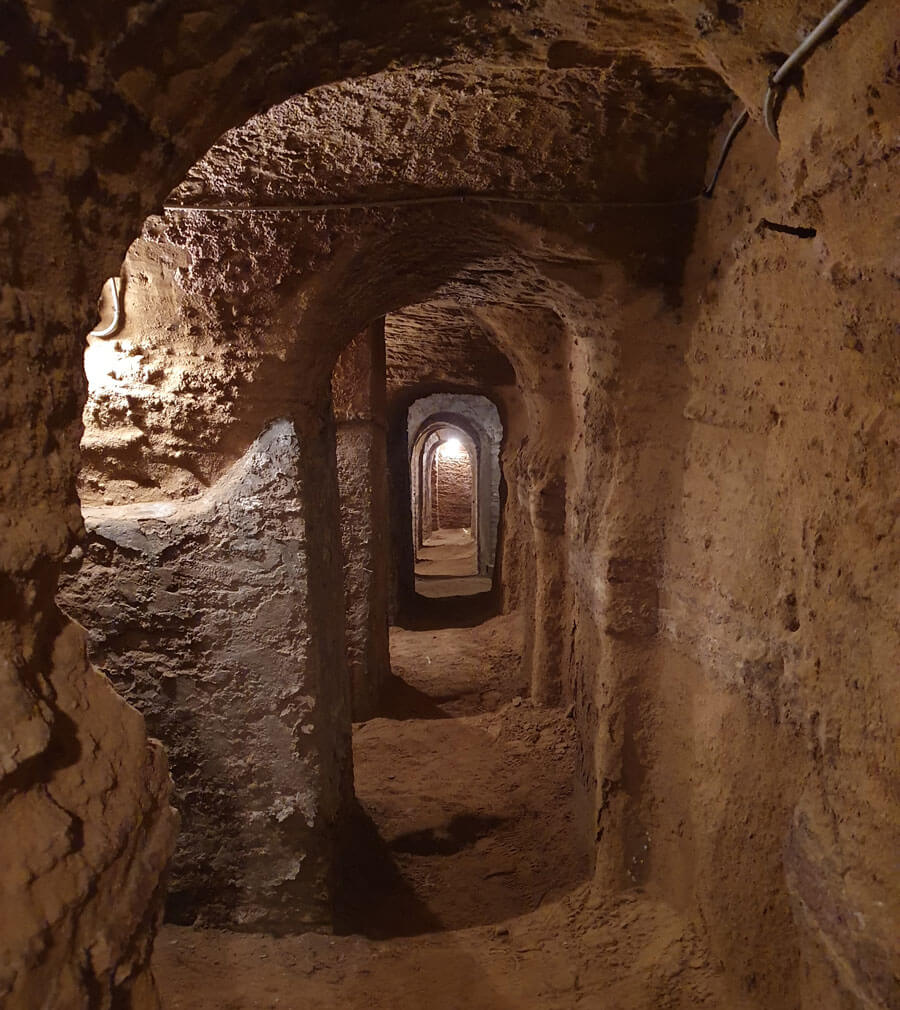
Over 160 caves burrow into the hillside, some of them joining up to make long and secret through-routes. Nowadays they are mostly in private ownership and some of the passageways are blocked at property boundaries. While wartime residents may have preferred communication between tunnels for sociability and to offer alternative exits in the case of bombing, subsequently privacy and security have intervened. Most caves aren’t visitable by the public, but guided tours will give you a good taste of Santarcangelo’s ‘underground city’.
Underground tours run several times every day from the tourist office in Santarcangelo, visiting the most accessible and interesting of the underground ‘labyrinths’. I recommend checking the tourist information website for the latest information in advance of your visit, especially if you want to book a tour in English: www.iatsantarcangelo.com/. By planning a visit during one of the town’s historic fairs I was able to book in advance for a special extended cave tour in Italian which visited more sites.
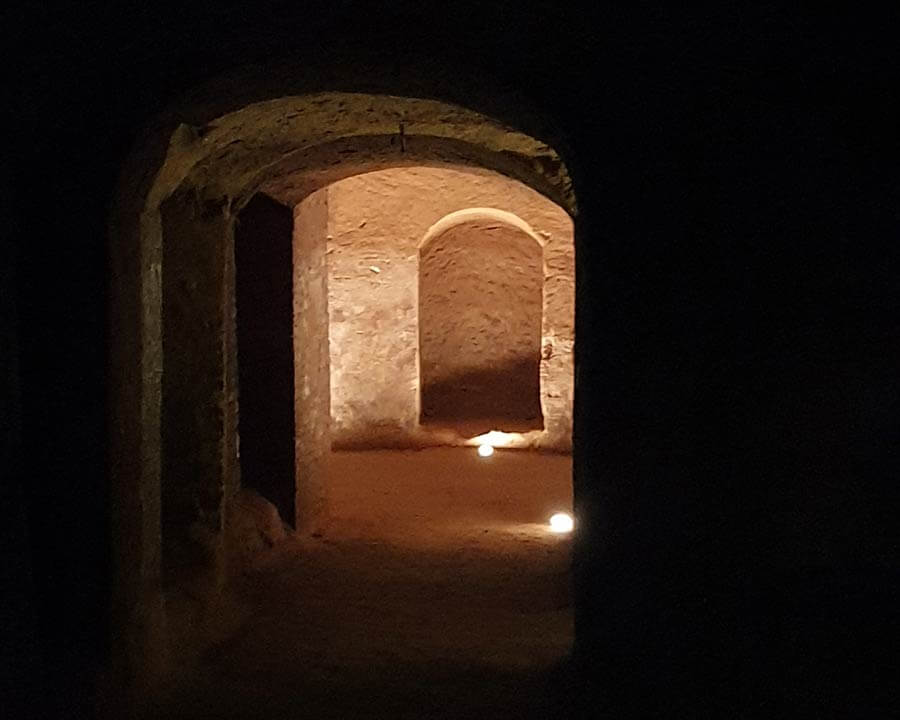
An underground tour is a very interesting and unusual way to spend an hour or so of your time in Santarcangelo. As well as the enjoyable sense of subterranean adventure, a cave tour gives extra insight into the past of the town and its citizens.
The regular tour visits the Grotta Monumentale, which was donated to the town by the family who owned it. The dramatic and unusual low arches just inside are the upper part of a colonnade, originally part of the cloister of the demolished monastery of St Francis which stood near the triumphal arch in Piazza Ganganelli. Further underground, visitors encounter other secret spaces and subterranean galleries where you’ll learn more about the history, geology, speculation and myth associated with these caves.
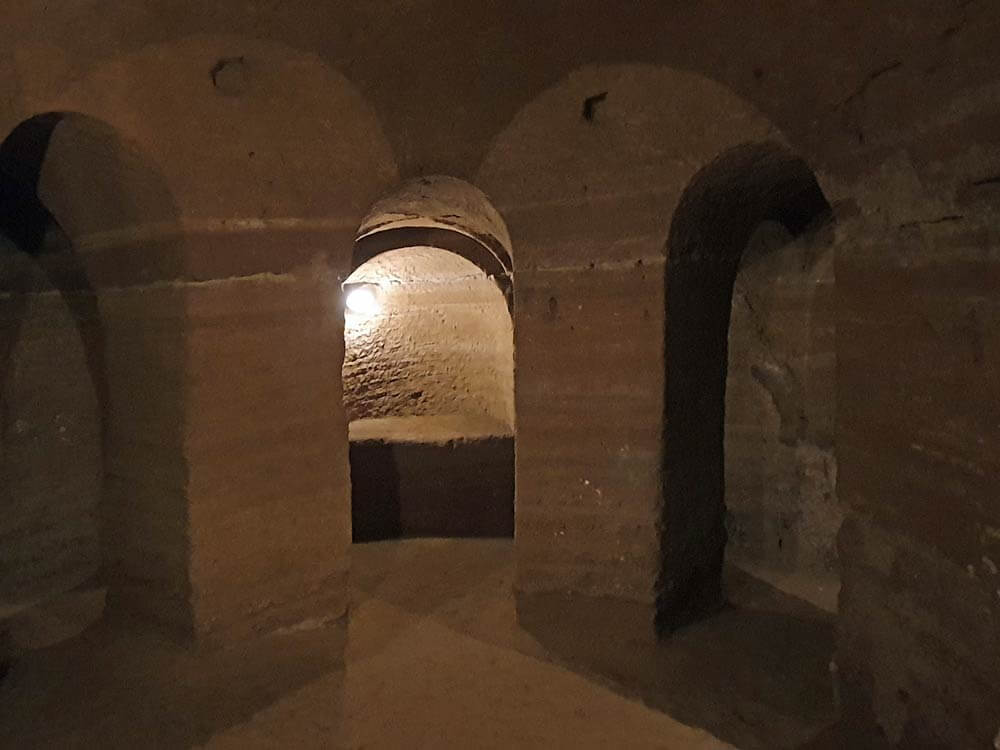
When I strolled around Santarcangelo during the afternoon of the fair it was also possible to see into a few private grottoes; several properties and businesses had open doors with passers-by invited to enter and take a look. A number of business including restaurants have cellars and caves which are in use and which customers or diners might get a chance to glimpse or even enter, so keep your eyes open as you explore the town, and don’t be shy to ask.
Another sight to look out for underfoot is the presence of hundreds of grain storage pits dating back to the Middle Ages. Useful in times of siege, most of these cellars are now blocked up, but are indicated by the word ‘granaio’ (granary) etched into paving stones.
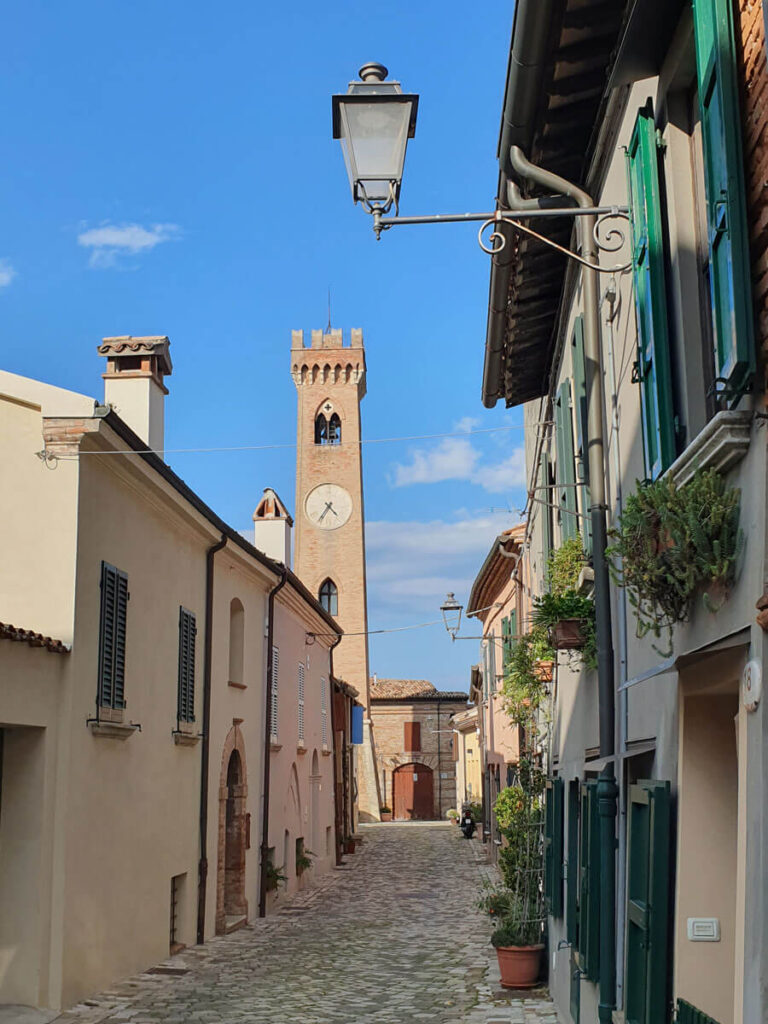
Exploring Santarcangelo di Romagna
Whether you arrive by public transport or car, your first big sight of Santarcangelo will probably be Piazza Ganganelli, the main square of the modern-day town. A large space surrounded by monumental buildings including a school, the piazza is dominated by a grand triumphal arch, the Arco Ganganelli. This was constructed to commemorate the 1769 election of Cardinal Lorenzo Ganganelli, born here in Santarcangelo di Romagna, as Pope Clement XIV. By the time the arch was completed in 1777 the Pope had been dead over two years, but his memory remains celebrated here in the town of his birth.
The lively heart of the ‘modern’ town lies between this large square with its Papal triumphal art and a 20th-century fountain, and the slopes nearby which climb towards the old historic heart of Santarcangelo. There are bustling businesses and cafés just beyond the piazza. Then streets begin to wind uphill, dotted with more hostelries and ‘destination’ type restaurants and bars. This is a good moment to head to the tourist office on Via Battisti (to the left) if you haven’t already dropped by to pick up a map or booked a guided cave tour.
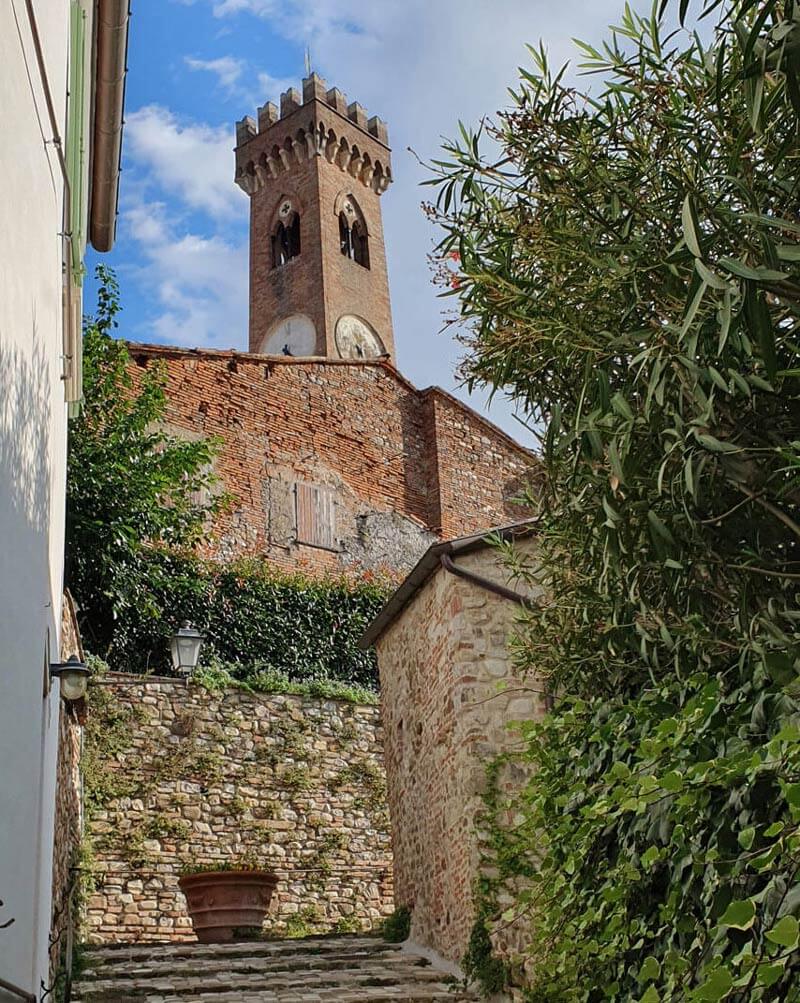
The historic heart and hub of Santarcangelo was once up on the low fortified hilltop, protected by town walls, gateways and a fortress. Originally the commercial centre, its status was usurped by newer developments down on the plain below. Our 80-year-old cave-guide remembered the hilltop centro storico area as run-down and rather dangerous in his childhood. Nowadays, after a renaissance, its historic buildings are restored and there’s a quietly well-to-do residential atmosphere.
Up along the top of the hill, which is called the Colle Giove, are three particularly notable buildings. One is the tall clock and bell tower, the Torre Campanaria. A landmark visible from all around, this 1893 tower in neo-Gothic style is topped with a weathervane in the form of town patron St Michael. It replaced an earlier tower which stood nearby.
Heading along the attractive and peaceful streets will bring you to an imposing octagonal building which is reminiscent of a church baptistery, but which is actually a water tower. The Serbatoio Bellaere is a 1931 structure built for function but with attractiveness in mind;an admirable and very Italian concept. There’s some interesting street art nearby to look out for, too.
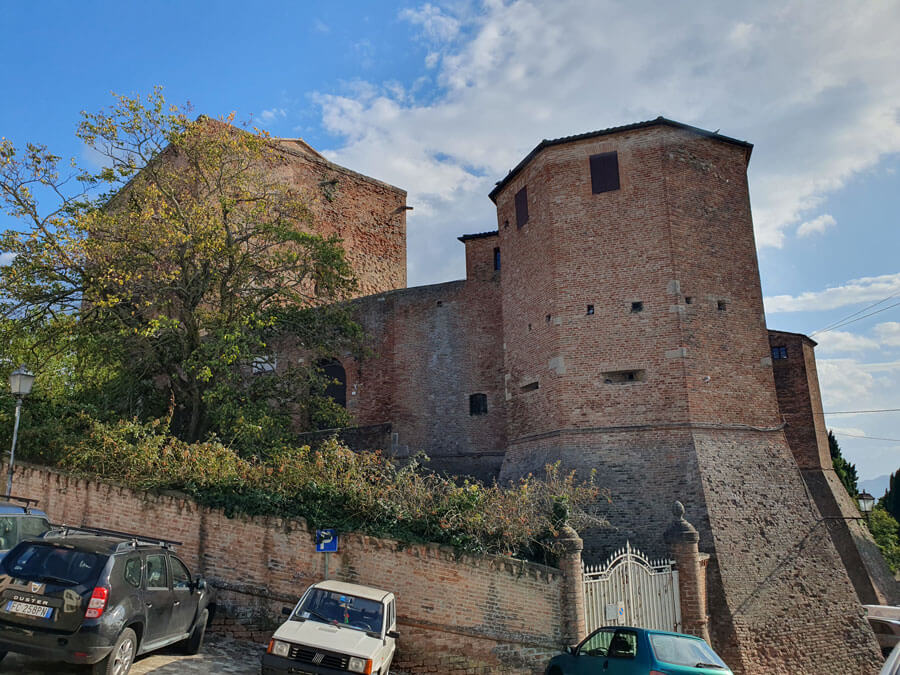
At the end of the ridge, surveying the plain, is Santarcangelo’s 15th-century castle, built by the Malatesta family: the Castello Malatestiano. In private (and aristocratic) ownership, the castle isn’t generally open to the public, but it hosts events and may be possible to visit on privately-organised tours: look out for posters in town or contact via the website: Castello di Santarcangelo di Romagna.
Other photogenic and interesting spots as you explore the old town, encircled by sections of town wall, include the picturesque Piazzetta delle Monache, named after the nuns who still live in a convent here (where you can sleep – see my accommodation links above). There is also an entrance to a cave complex in this little square, which I was lucky enough to visit on a special tour, though it isn’t generally open to the public at the time of writing. This is a good time to take a pause from exploring, and visit the town’s main museum.
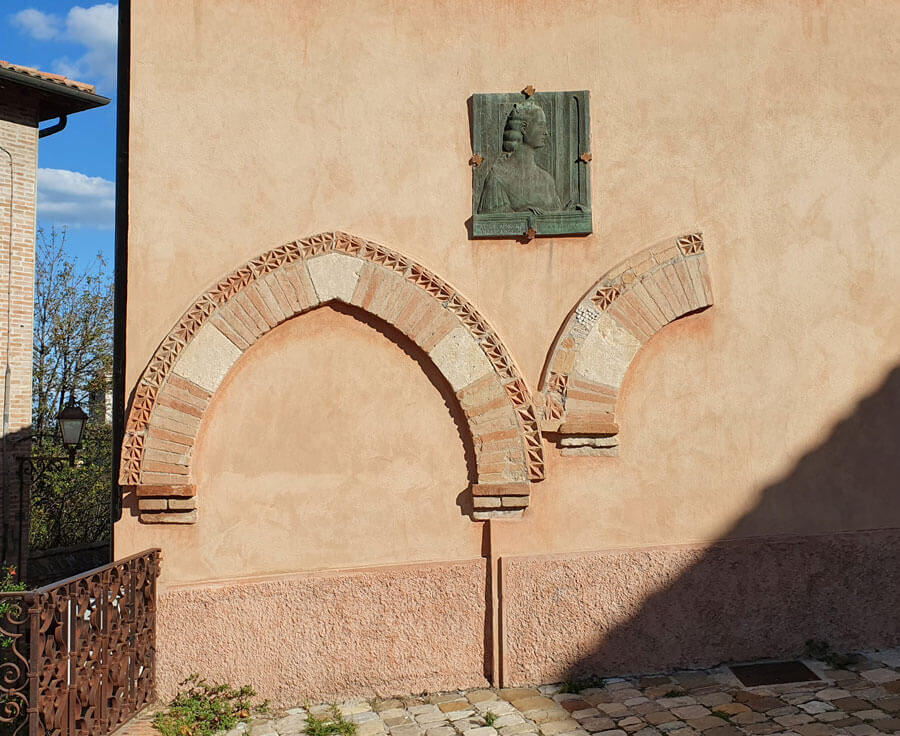
Santarcangelo museums
On the street next to Piazzetta delle Monache is the town’s Museo Storico Archeologico, MUSAS (limited opening days/times). This small historical and archaeological museum, housed in a historic palazzo, is well worth visiting, and is also free at the time of writing. The exhibits begin with archaeological finds from the Roman era, including the remains of kilns. Highlights include a small bronze statuette of Harpocrates, a deity from Hellenistic Egypt. Information boards in English and Italian provide context to the displays.
Though small, the museum collection is interesting and well-presented with a contemporary sensibility. One historic painting, previously on loan here for a time, has been commemorated with a ‘substitute’ tribute by acclaimed graffiti artist Eron, from Rimini. The finest work of art in the museum is probably the beautiful polyptych in an elaborate gilded frame of the Madonna and Child, Crucifixion and saints by Jacobello di Bonomo, dated to 1385.
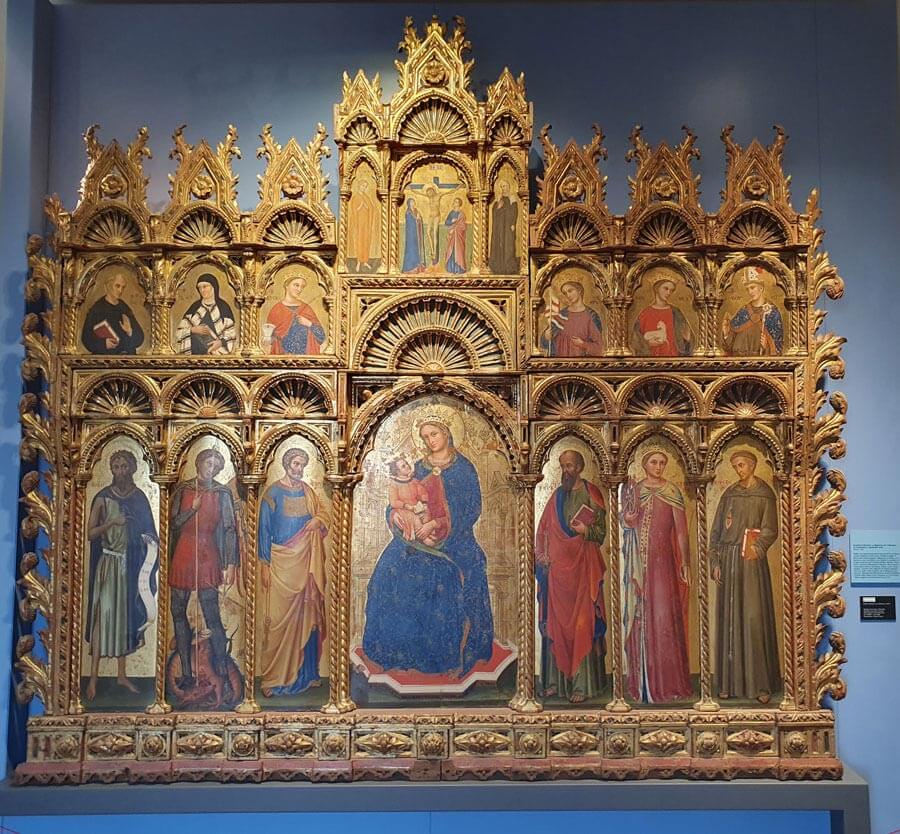
Quirkier exhibits include a brick carved with a rude message by a fed-up workman over a hundred years ago. A couple of rather quaint portraits of local dignitaries are accompanied by a dignified painting of local celebrity Pope Clement XIV, which he may have presented to his hometown along with other mementos on display here.
This isn’t the only museum in Santarcangelo; there is also an Ethnographic Museum (MET), the Museo Tonino Guerrra, which remembers the poet, artist and screenwriter born here, and the town’s most quirky destination: a museum dedicated to buttons: the Museo del Bottone. All have limited and seasonal opening times, which I’d recommend checking in advance, but during one of the town festivals is a good time to find the local sights and museums welcoming visitors.
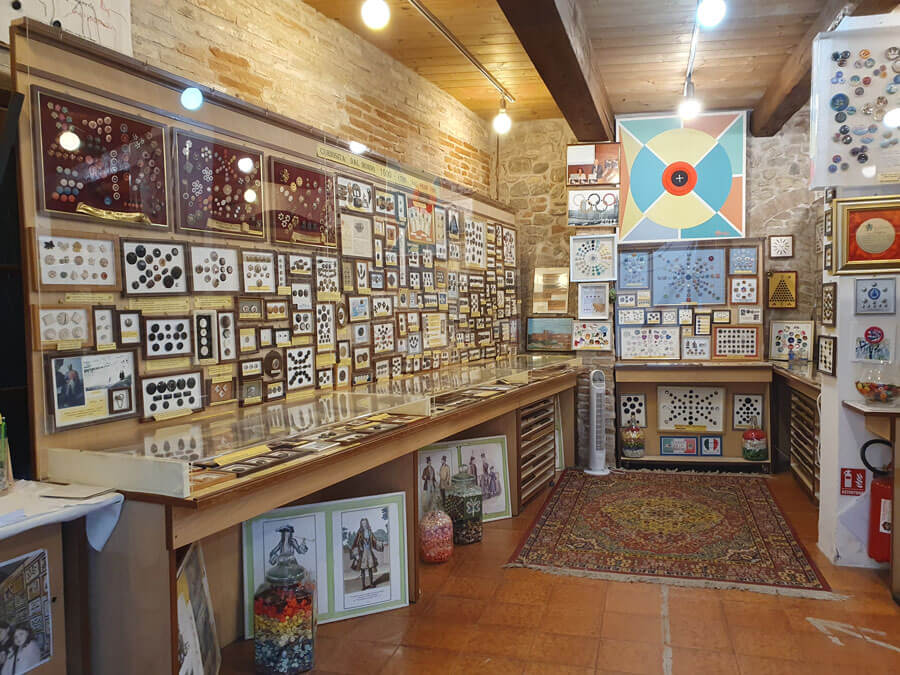
Gateways, angels, views historic sports and churches
Exploring the lanes which wind around the slopes of Colle Giove, you’ll find a couple of historic gateways still standing in stretches of Santarcangelo’s defensive town wall. Travellers and locals passing through the Porta del Campanone Vecchio seem to have felt in need of extra protection, too. There are shrines to the Madonna on both sides of the gate.
Near this gateway, where the town’s original bell tower once stood, visitors can walk out onto a panoramic terrace. Winding past front doors, this offers excellent views over the lower town, with the sea on the horizon and the landscape of Emilia-Romagna, stretching towards the great crag of San Marino making a shimmering green backdrop.
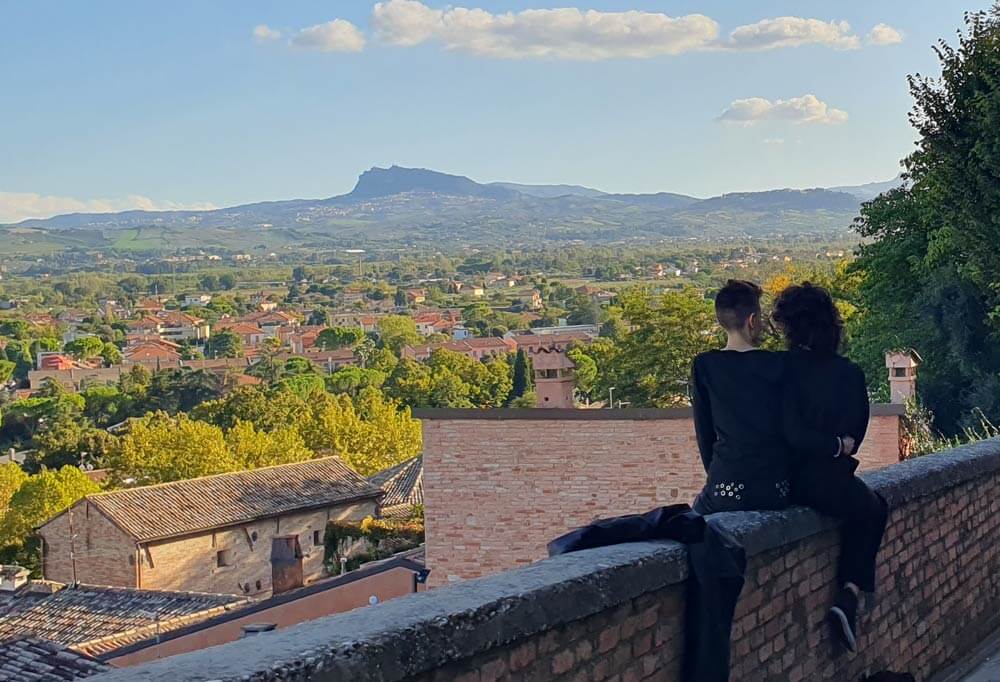
Beneath the slopes is one of Santarcangelo’s most significant churches, the Chiesa Collegiata. Although the building dates to the 18th century, it houses art from earlier centuries including a 14th-century crucifix.
A much older church, possibly with origins in the 6th century, is just outside the town. The Pieve di San Michele Arcangelo was the original home of the historic crucifix now in the Chiesa Collegiata. The ancient building, while bare, is worth a visit, but I’d recommend checking opening times with the tourist office first. There is a legend that the Malatesta lords who owned the castle had a tunnel created which ran underground all the way from the castle to the church, a distance of around half a mile, through which they could escape on horseback if the town was besieged.
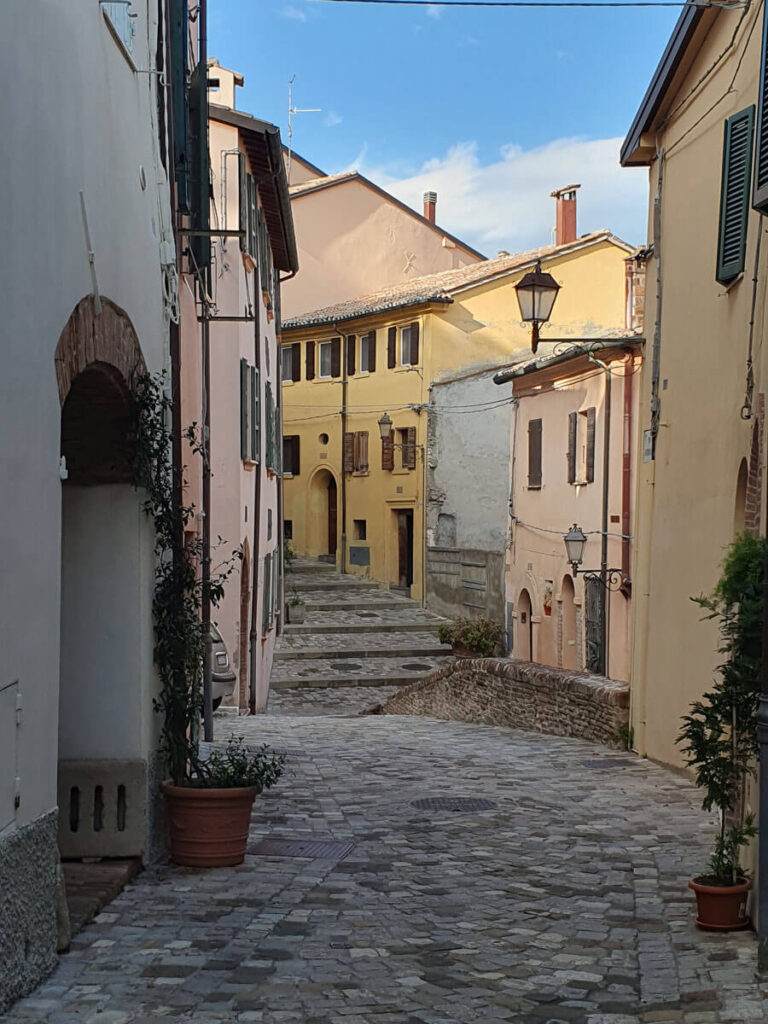
Back in the old town and close to another defensive gateway, the Porta Cervese (named as the road ran from here to the salt pans at Cervia), look out for signs of local devotion: the Archangel protector of Santarcangelo celebrated in modern fashion on the walls of a home.
While the majority of Santarcangelo’s most scenic spots are in the historic centre and in the lanes ascending to it, there are also some good views from below the town walls.
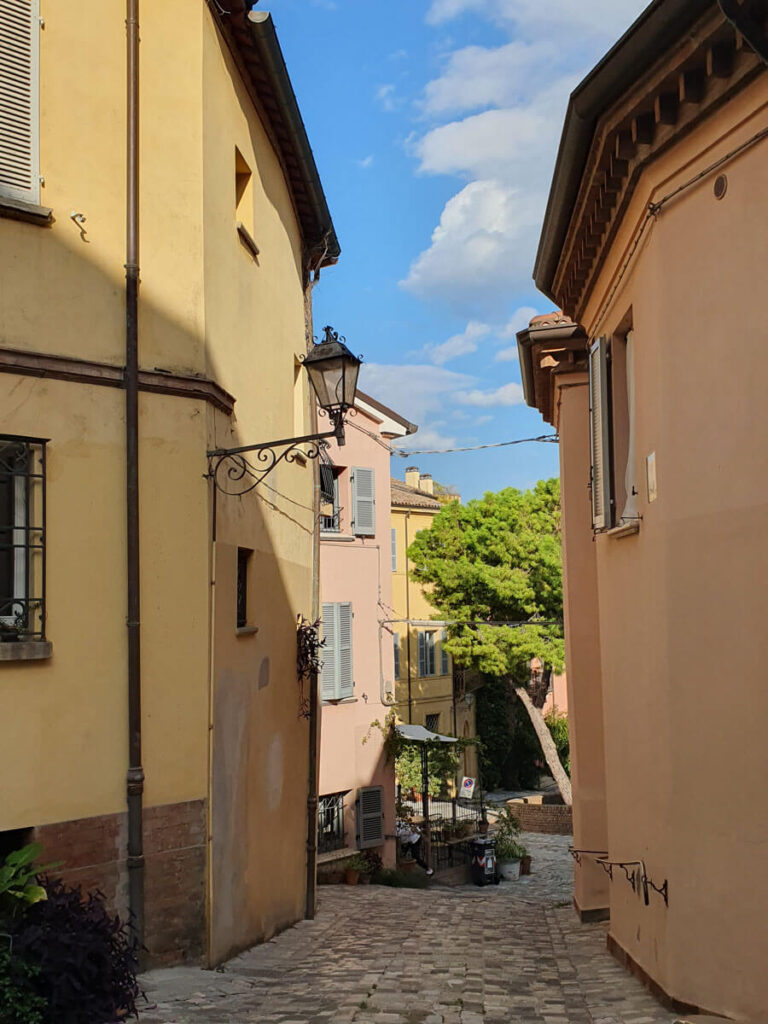
A grassy park, the Campo della Fiera, alongside Piazzale Marconi, reachable by continuing along Via Battisti past the tourist office, provides a handsome green setting for a view of the historic town on its low hill rising above trees. Against the town wall here is a dusty court called the Sferisterio. This is the venue for two historic sports which are still played (or revived) today: pallone a bracciale and tamburello. I enjoyed watching part of a tamburello tournament held during the Fiera di San Michele; it was fascinating to watch and hotly competed.
There are public toilets across the Campo della Fiera park from the Sferisterio, and I also found nice, clean toilets in the free town museum.
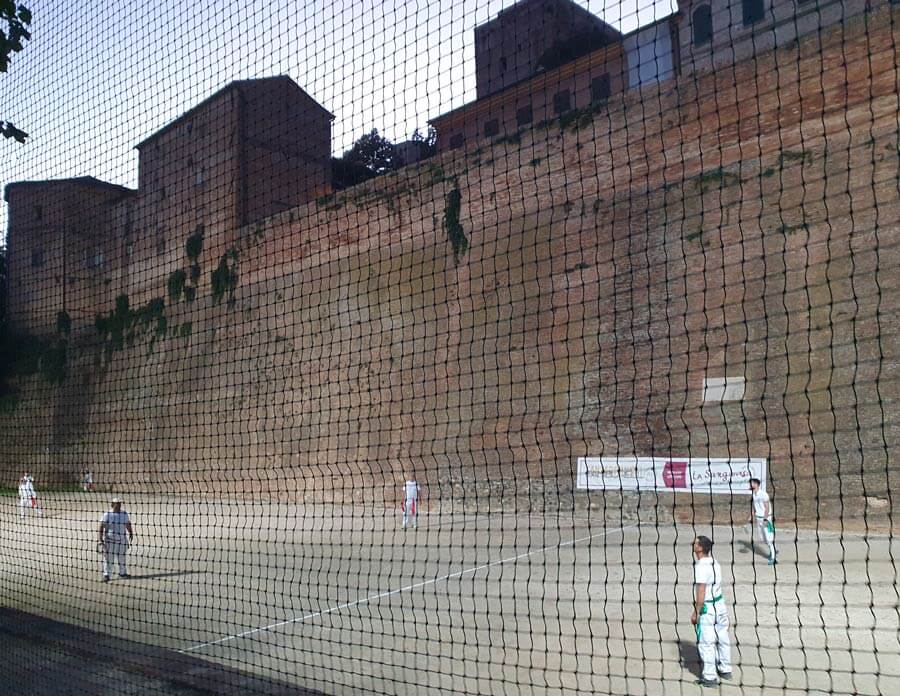
A unique boutique: Stamperia Marchi
The Stamperia Marchi is a fascinating shop to visit, and one of the historic sights of the area. Since 1633 this family firm has been producing printed fabrics using the same traditional colours, designs and techniques. The boutique in the heart of town is filled with luxury hand-printed household linens and decorative items, along with some more modern gifts and keepsakes (I bought a T-shirt printed with the town’s archangel protector).
If you are lucky, you may get an explanation or demonstration of their historic wooden stamp-printing methods used with traditional local rust dyes. And in a room behind the shop is a really remarkable survival, a historic curiosity dating to the 17th century: a large man-powered wooden wheel kept in motion by walking within the structure (see videos of it in action on the business’s website). This mangano is a kind of mangle, still used today to press fabric in preparation for dyeing. If you book a guided tour through their website (there’s a minimum number of participants required) you can see this fascinating piece of industrial history in action.
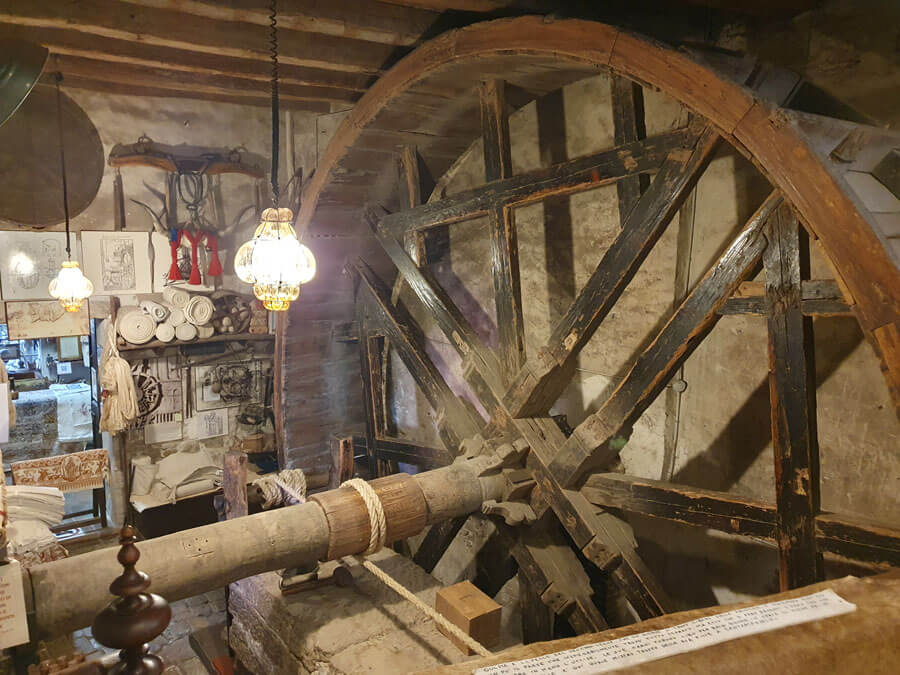
Eating and drinking
While it still has a charming and authentic local atmosphere, Santarcangelo is comfortably used to attracting trippers from Rimini and the nearby beach resorts. So there’s a good choice of places to eat and drink, whether you’d rather enjoy an outdoor street table or a intimate dinner in a romantic grotto-like interior. You can enjoy the best of Emilia-Romagna’s cuisine here, along with local wines like the prized red Sangiovese. Another story about the town claims that this wine was named for the Santarcangelo’s hill, Colle Giove.
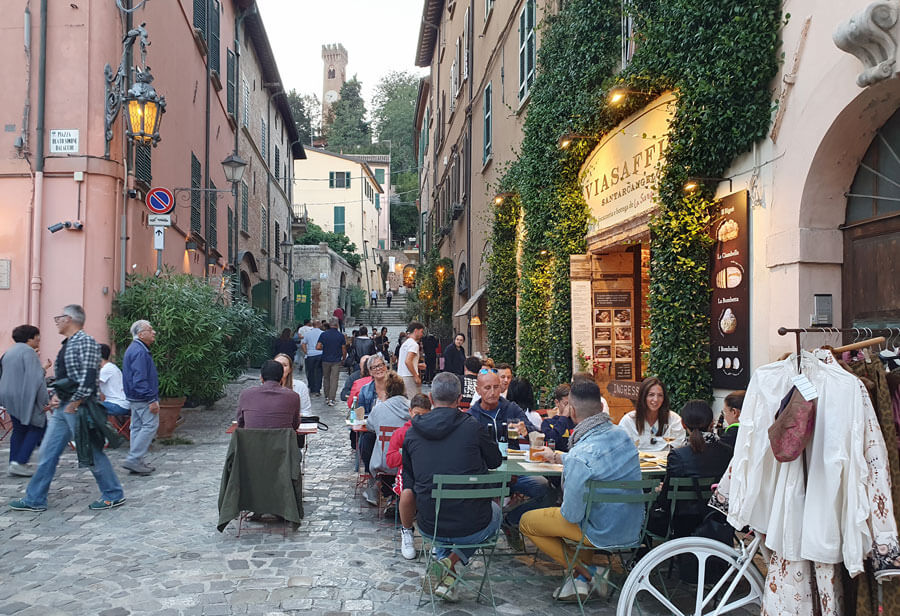
Local institution La Sangiovesa is a popular and atmospheric osteria in the heart of town, ideal for sampling regional Romagnola specialities from its seasonal menu. This is another place with its own caves beneath the building. Just over the lane from the restaurant is Via Saffi 32, a focacceria run by the same management for those wanting lighter lunches or a glass of wine with food.
One of the caves I visited on my special guided tour was in the restaurant Calycanto. This would definitely be one of the most interesting places for an evening meal, its menu combining local products, international cuisine and bold flavour combinations.
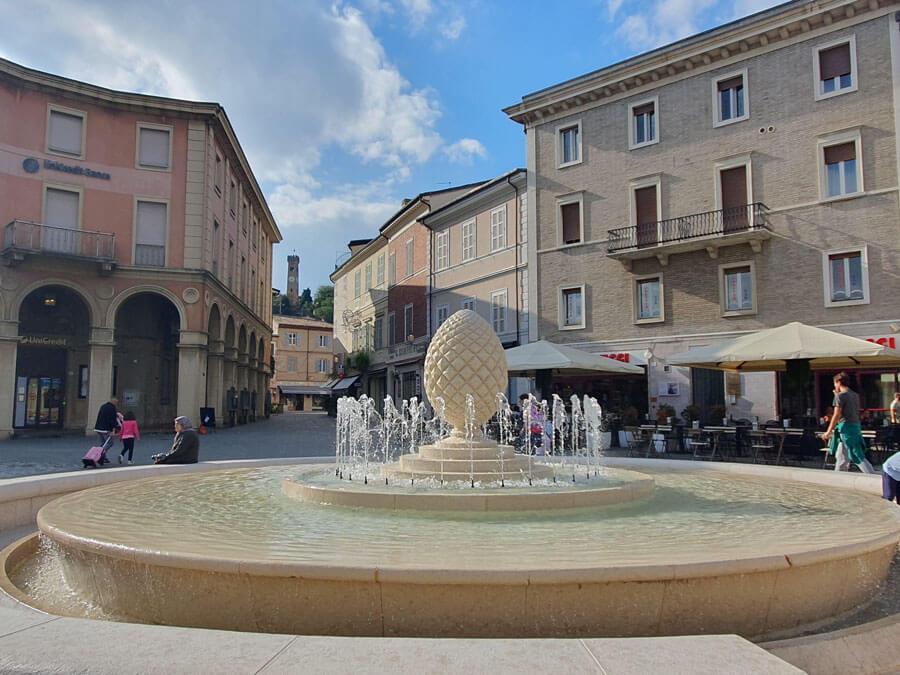
If you’re interested in learning more about the local grapes and wines, there are opportunities to taste and buy at wineries close to town: try the Azienda Agricola Collina dei Poeti or Casa Vinicola Battistini. For foodies driving around the area, the organic farm shop at La Società Agricola L’Arcangelo sounds worth a visit for fruit, vegetables, wine and other seasonal products.
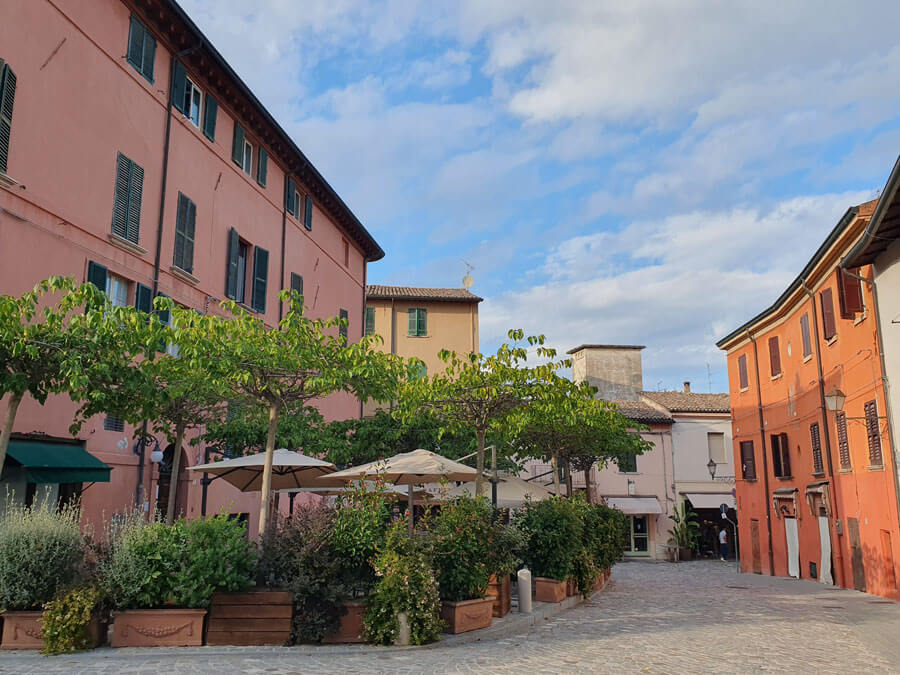
Travel to Santarcangelo di Romagna
Santarcangelo di Romagna is six miles from Rimini and is easily reached by public transport. The best way to travel between the two towns is by bus. Bus 9 takes around 25 minutes for the journey from a stop outside Rimini’s railway station to Santarcangelo. The bus service is operated by Start Romagna and you can find timetables on their website; when I visited I found the timetables and routes were well integrated with Google Maps. Most (not all) of the buses on the route start at Rimini airport before travelling through Rimini, including stops by the Arch of Augustus, the railway station and in Via dei Mille. From here most of the services continue all the way to Santarcangelo – though again, not all, so check timetables attentively. I found the buses frequent, fairly punctual and convenient. In Santarcangelo there’s a bus stop by the town hall (Municipio) in the main square in the lower part of town, Piazza Ganganelli.
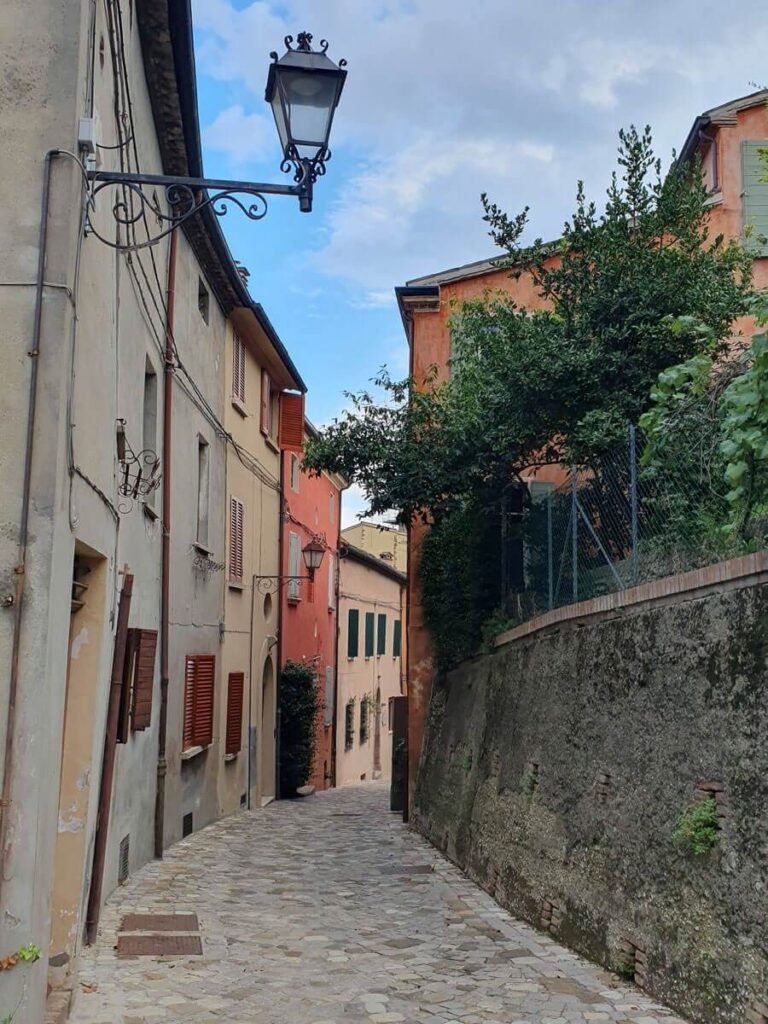
Santarcangelo di Romagna also has a railway station, which is served by some regional trains on the route between Rimini and Bologna. However, if you are travelling from Rimini, I’d recommend the bus as a more convenient way to travel. The railway station is a mile’s walk from the centre, a trek which includes having to detour for several minutes to a pedestrian crossing over a busy main road, and a long walk down a fairly unfrequented residential street on the edge of town.
Car drivers will find a number of car parks in piazzas around the town centre.
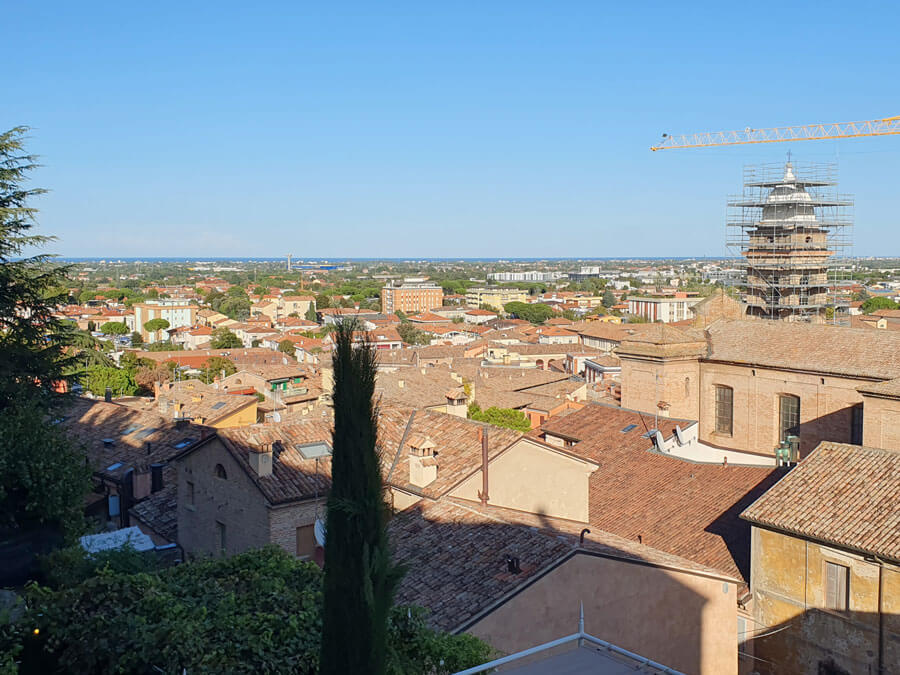
Fairs and events in Santarcangelo
I visited Santarcangelo di Romagna on a September weekday afternoon, when the town was peaceful and felt quite off-the-beaten-track. There were just a handful of other outsiders sightseeing, and the only crowds were the Santarcangiolesi parents picking children up from school in a convivial gathering in Piazza Ganganelli.
I caught the bus from Rimini again the following Saturday for one of Santarcangelo’s annual celebrations, the Fiera di San Michele, and found a transformed scene with locals and visitors thronging through the stalls of a cheerful market, filling up on street food, and assembling for guided cultural tours. This time the museums were open, as were more boutiques, and I was able to go on the special guided tour I described above.
Both visits had their charms and I wouldn’t have missed either. I’d say: if you have the chance to time your visit with a special event – of which the town has several – then you should make the most of the opportunities. But for a slow travel experience, photo-opportunities and a break from the city, Santarcangelo is great at quieter times too. My photographs of empty lanes date to the weekday visit!
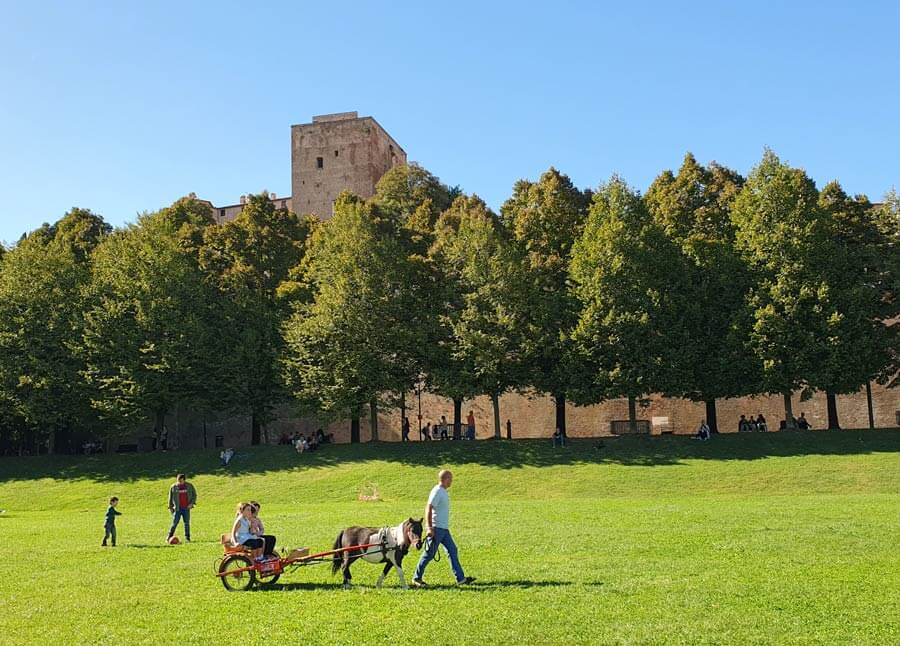
The Fiera di San Michele is a fair or festival celebrating the patron saint of Santarcangelo di Romagna, St Michael Archangel. It’s the most ancient fair held here, and takes place on or close to the feast day of St Michael on 29th September. When I visited this lasted a whole weekend, with food and market stalls, feasting, special events, artwork, and cultural tours as well as religious celebrations. Historically the fair was closely tied to animals and livestock, and there are still elements recalling this.
I particularly enjoyed the chance to watch the 16th-century sport of tamburello in a tournament held by at the Sferisterio by the town wall. Local teams identified by coloured sashes whack a heavy ball to and fro using tambourine-like bats; it’s impressive to watch, and obviously requires a lot of skill and teamwork as well as a determination to argue with the linesmen/women over calls of ‘out’.
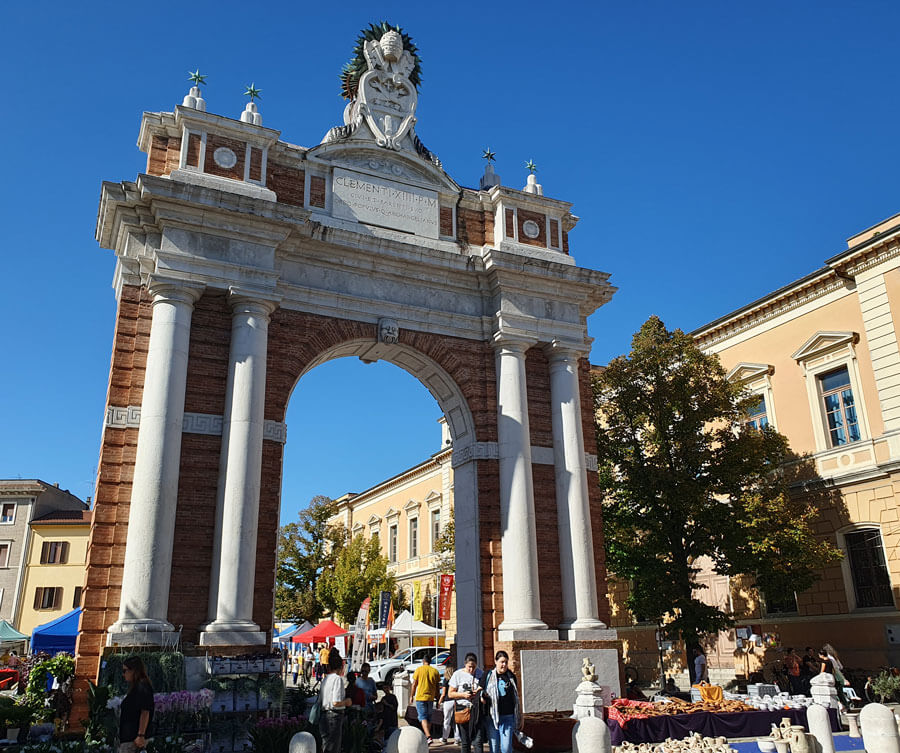
The Fiera di San Martino is held a couple of months later, celebrating the feast day of St Martin on 11th November. Again this lasts over a whole weekend with some similar features and a big emphasis on food and storytelling. The unique feature of this festival is a ‘test of cuckoldry’. San Martino is supposed to be the patron saint, among other things, of betrayed husbands (cuckolds, who are ‘cornuti‘, ‘horned’ in Italian); there are some interesting theories about why. In Santarcangelo a pair of decorated horns is hung under the arch of the Arco Ganganelli and when a cuckolded husband passes underneath, it’s said the horns will move.
Buses still run to the town centre of Santarcangelo during festivals, and I didn’t find my buses as crowded as I’d expected. The bus simply finished its route at a stop just before reaching the market-filled piazza, and departs from the same place – double check locally to be sure, though. There is useful practical information as well as programmes for the fairs on the official website: www.santarcangelofiere.it/
Another big annual event held locally is the Santarcangelo Festival, a celebration of contemporary street theatre. There are many smaller events throughout the year, though, so if you’re visiting, especially if you speak Italian, I’d check the various local tourism/fair websites I’ve linked on this page to see if you might come across any interesting shows, tours or tastings.
